CHEVROLET ASTRO PASSENGER 1994 1.G Manual PDF
Manufacturer: CHEVROLET, Model Year: 1994, Model line: ASTRO PASSENGER, Model: CHEVROLET ASTRO PASSENGER 1994 1.GPages: 340, PDF Size: 16.86 MB
Page 71 of 340
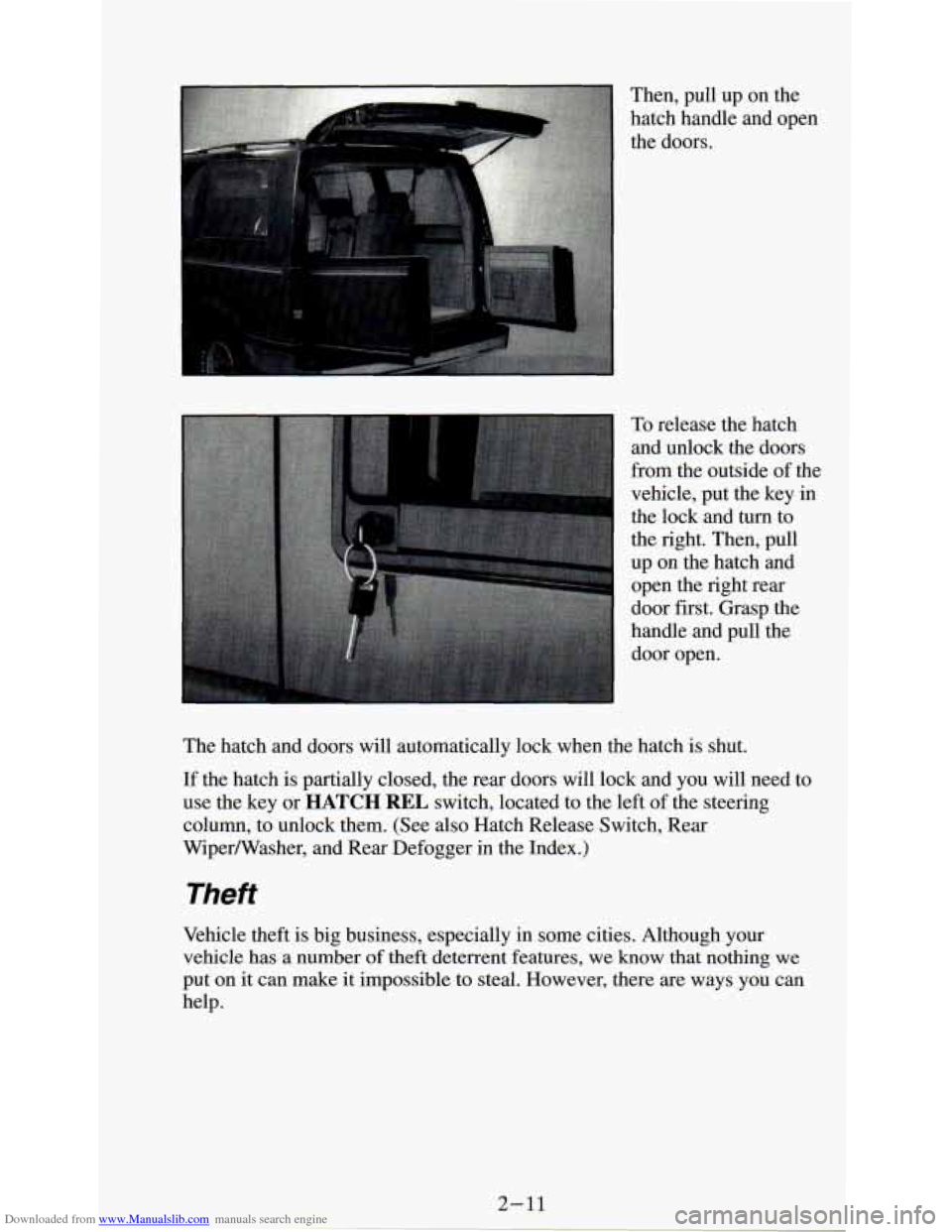
Downloaded from www.Manualslib.com manuals search engine Then, pull up on the
hatch handle and open
the doors.
To release the hatch
and unlock the doors
from the outside of the
vehicle, put the key in
the lock and turn to
the right. Then, pull
up on the hatch and
open the right rear
door first. Grasp the
handle and pull the
door open.
The hatch and doors will automatically lock when the hatch is shut.
If the hatch is partially closed, the rear doors will lock and you will need to
use the key or
HATCH REL switch, located to the left of the steering
column, to unlock them. (See also Hatch Release Switch, Rear
WiperNasher, and Rear Defogger in the Index.)
Theft
Vehicle theft is big business, especially in some cities. Although your
vehicle has
a number of theft deterrent features, we know that nothing we
put on
it can make it impossible to steal. However, there are ways you can
help.
2-11
Page 72 of 340
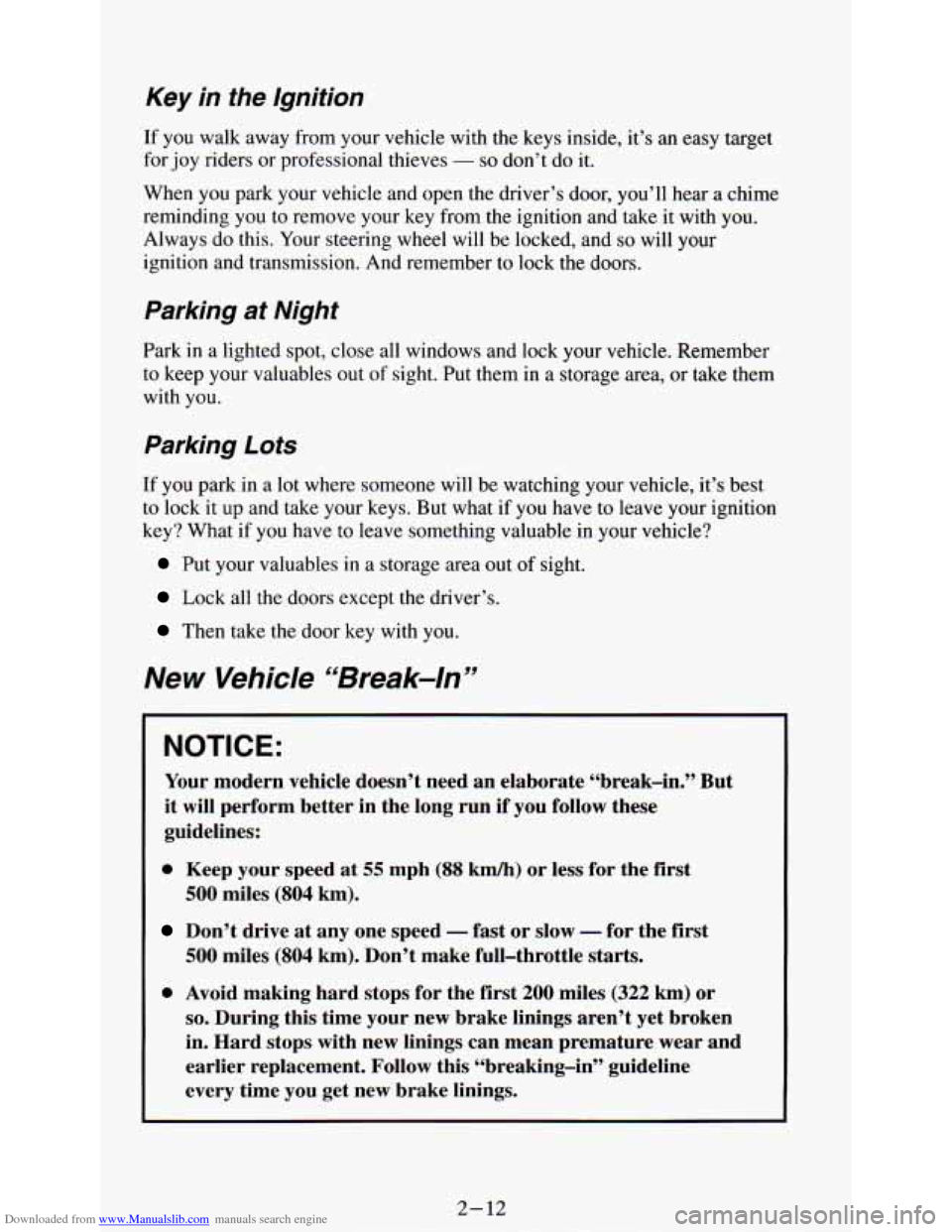
Downloaded from www.Manualslib.com manuals search engine Key in the Ignition
If you walk away from your vehicle with the keys inside, it’s an easy target
for joy riders or professional thieves
- so don’t do it.
When you park your vehicle and open the driver’s door, you’ll hear
a chime
reminding you to remove your key from the ignition and take it with you.
Always do this. Your steering wheel
will be locked, and so will your
ignition and transmission. And remember to lock the doors.
Parking at Night
Park in a lighted spot, close all windows and lock your vehicle. Remember
to keep your valuables out
of sight. Put them in a storage area, or take them
with you.
Parking Lots
If you park in a lot where someone will be watching your vehicle, it’s best
to lock
it up and take your keys. But what if you have to leave your ignition
key? What
if you have to leave something valuable in your vehicle?
Put your valuables in a storage area out of sight.
Lock all the doors except the driver’s.
Then take the door key with you.
New Vehicle “Break-In ”
NOTICE:
Your modern vehicle doesn’t need an elaborate “break-in.” But
it will perform better in the long run if you follow these
guidelines:
0 Keep your speed at 55 mph (88 km/h) or less for the first
500 miles (804 km).
Don’t drive at any one speed - fast or slow - for the first
500 miles (804 km). Don’t make full-throttle starts.
0 Avoid making hard stops for the first 200 miles (322 km) or
so. During this time your new brake linings aren’t yet broken
in. Hard stops with new linings can mean premature wear and
earlier replacement. Follow this “breaking-in” guideline
every time you get new brake linings.
2-12
Page 73 of 340
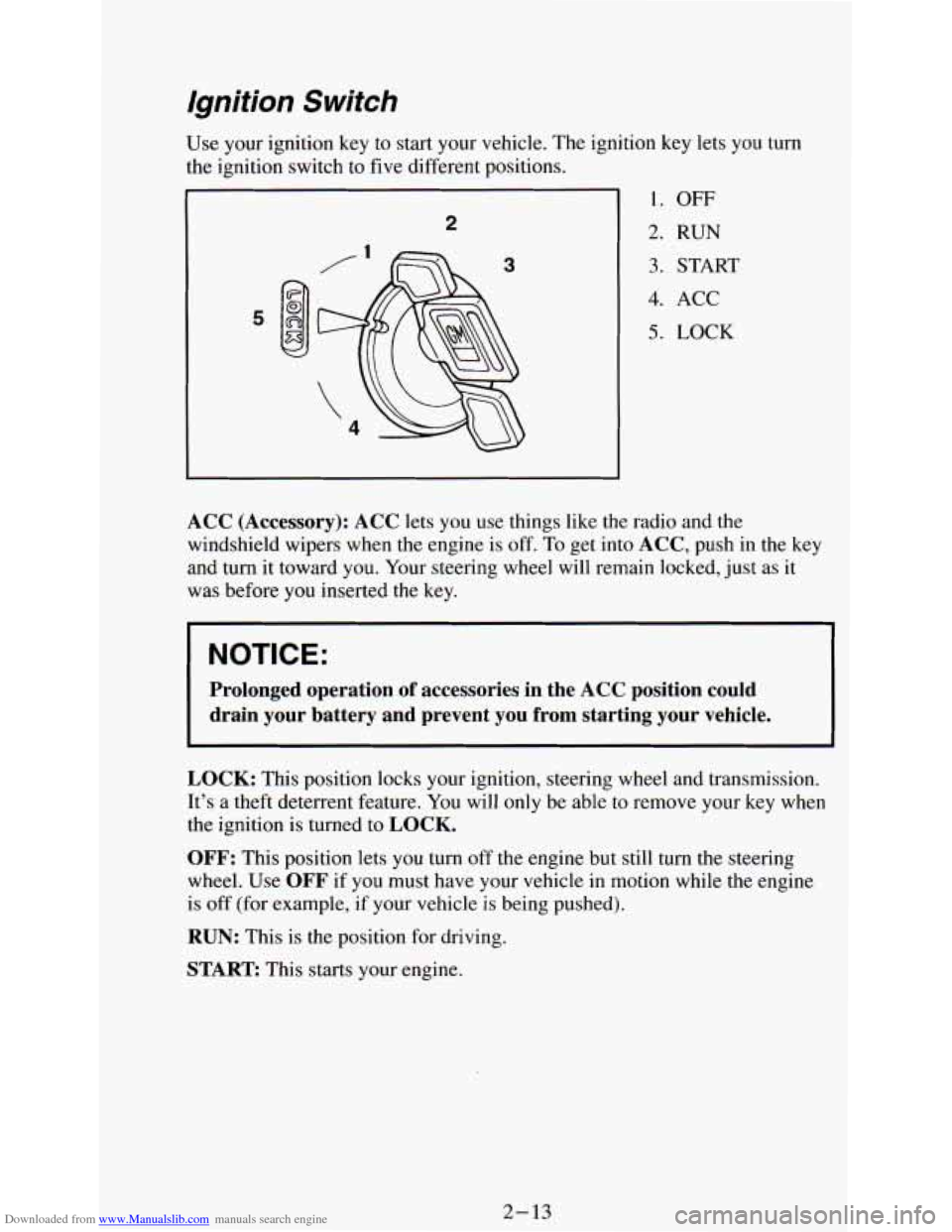
Downloaded from www.Manualslib.com manuals search engine Ignition Switch
Use your ignition key to start your vehicle. The ignition key lets YOU turn
the ignition switch to five different positions.
3
1. OFF
2. RUN
3. START
4. ACC
5. LOCK
ACC (Accessory): ACC lets you use things like the radio and the
windshield wipers when the engine is off. To get into
ACC, push in the key
and turn it toward you. Your steering wheel will remain locked, just as it
was before you inserted the
key.
NOTICE:
Prolonged operation of accessories in the ACC position could
drain your battery and prevent you from starting your vehicle. \
LOCK:
This position locks your ignition, steering wheel and transmission.
It’s a theft deterrent feature. You will only be able to remove your key when
the ignition is turned to
LOCK.
OFF: This position lets you turn off the engine but still turn the steering
wheel. Use
OFF if you must have your vehicle in motion while the engine
is off (for example, if your vehicle is being pushed).
RUN: This is the position for driving.
START This starts your engine.
2-13
Page 74 of 340
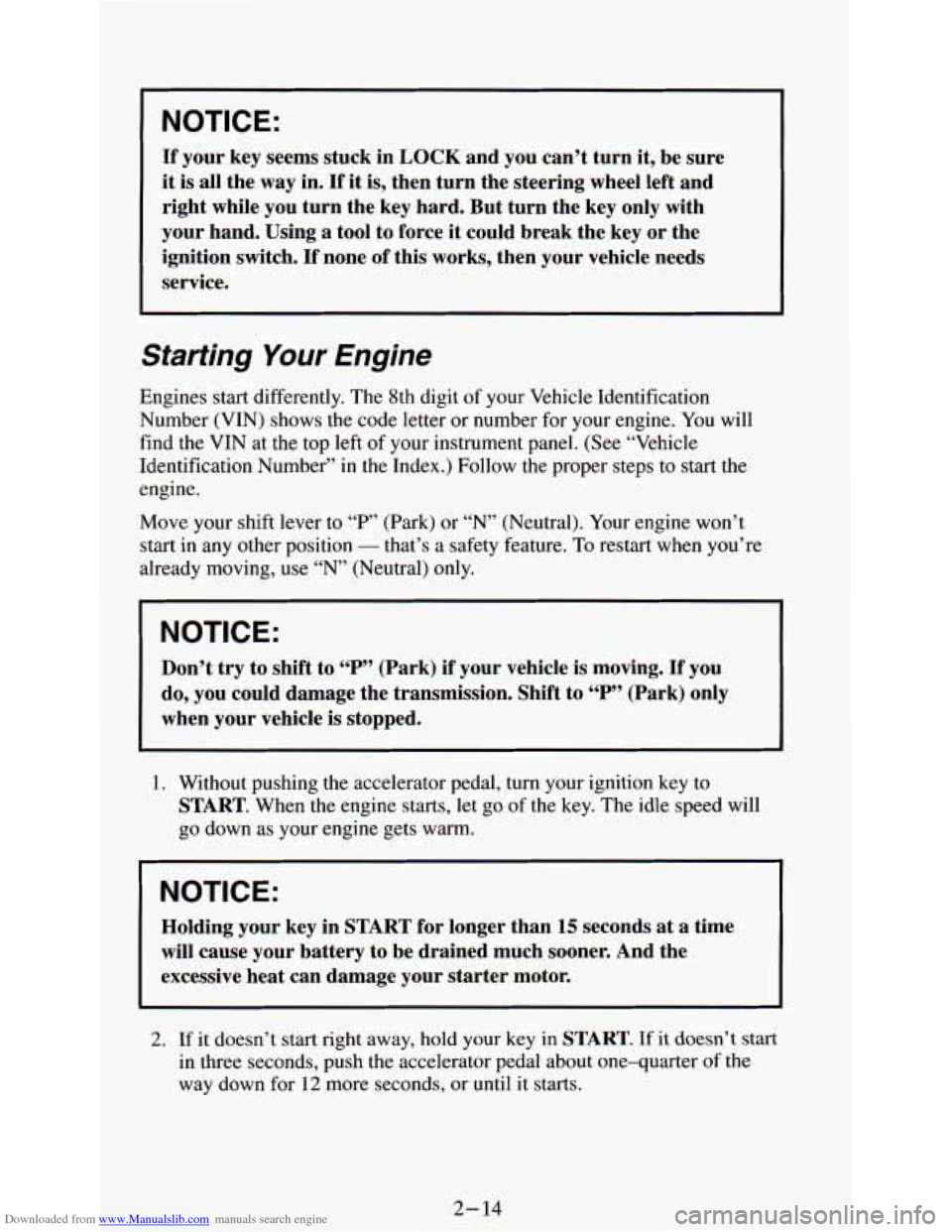
Downloaded from www.Manualslib.com manuals search engine I 1
I NOTICE:
If your key seems stuck in LOCK and you can’t turn it, be sure
it is
all the way in. If it is, then turn the steering wheel left and
right while you turn the key hard. But turn the key only with
your hand. Using
a tool to force it could break the key or the
ignition switch.
If none of this works, then your vehicle needs
service.
Farting Your Engine
Engines start differently. The 8th digit of your Vehicle Identification
Number (VIN) shows the code letter or number for your engine. You will
find the VIN at the top left of your instrument panel. (See “Vehicle
Identification Number”
in the Index.) Follow the proper steps to start the
engine.
Move your shift lever to
“P’ (Park) or “N” (Neutral). Your engine won’t
start in any other position
- that’s a safety feature. To restart when you’re
already moving, use
“N” (Neutral) only.
NOTICE:
Don’t try to shift to “P” (Park) if your vehicle is moving. If you
do, you could damage the transmission. Shift
to “P” (Park) only
when your vehicle
is stopped.
1. Without pushing the accelerator pedal, turn your ignition key to
START. When the engine starts, let go of the key. The idle speed will
go down as your engine gets warm.
NOTICE:
Holding your key in START for longer than 15 seconds at a time
will cause your battery to be drained much sooner. And the
excessive heat can damage your starter motor.
2. If it doesn’t start right away, hold your key in START. If it doesn’t start
in three seconds, push the accelerator pedal about one-quarter of the
way down for
12 more seconds, or until it starts.
2- 14
Page 75 of 340
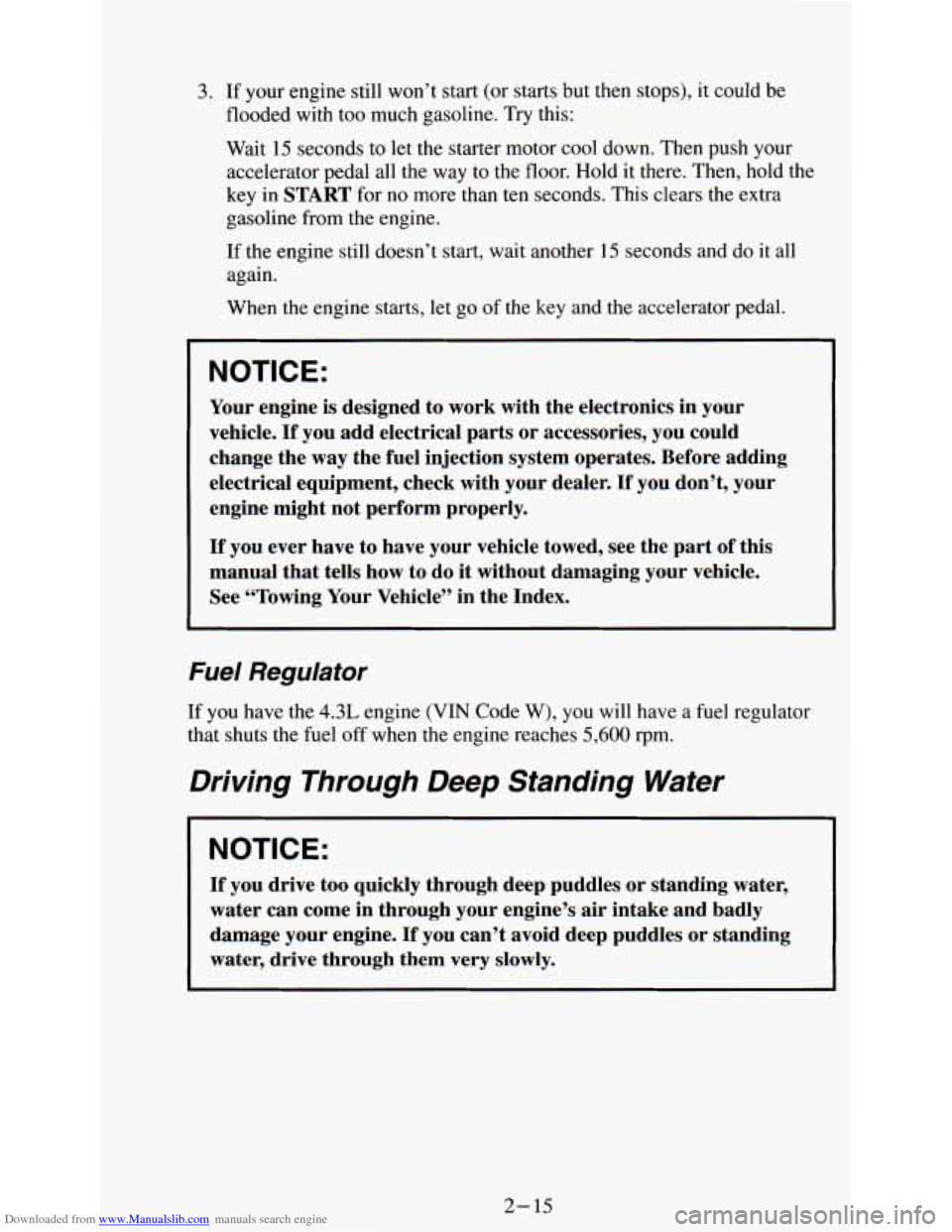
Downloaded from www.Manualslib.com manuals search engine 3. If your engine still won’t start (or starts but then stops), it could be
flooded with too much gasoline. Try this:
Wait 15 seconds to let the starter motor cool down. Then push your
accelerator pedal all the way to the floor. Hold it there. Then, hold the
key in
START for no more than ten seconds. This clears the extra
gasoline from the engine.
If the engine still doesn’t start, wait another 15 seconds and do it all
again.
When the engine starts, let go of the key and the accelerator pedal.
NOTICE:
Your engine is designed to work with the electronics in your
vehicle.
If you add electrical parts or accessories, you could
change the way the fuel injection system operates. Before adding
electrical equipment, check with your dealer.
If you don’t, your
engine might not perform properly.
If you ever have to have your vehicle towed, see the part of this
manual that tells how to do it without damaging your vehicle.
See “Towing Your Vehicle” in the Index.
Fuel Regulator
If you have the 4.3L engine (VIN Code W), you will have a fuel regulator
that shuts the fuel off
when the engine reaches 5,600 rpm.
Driving Through Deep Standing Water
NOTICE:
If you drive too quickly through deep puddles or standing water,
water can come in through your engine’s air intake and badly
damage your engine.
If you can’t avoid deep puddles or standing
water, drive through them very slowly.
2- 15
Page 76 of 340
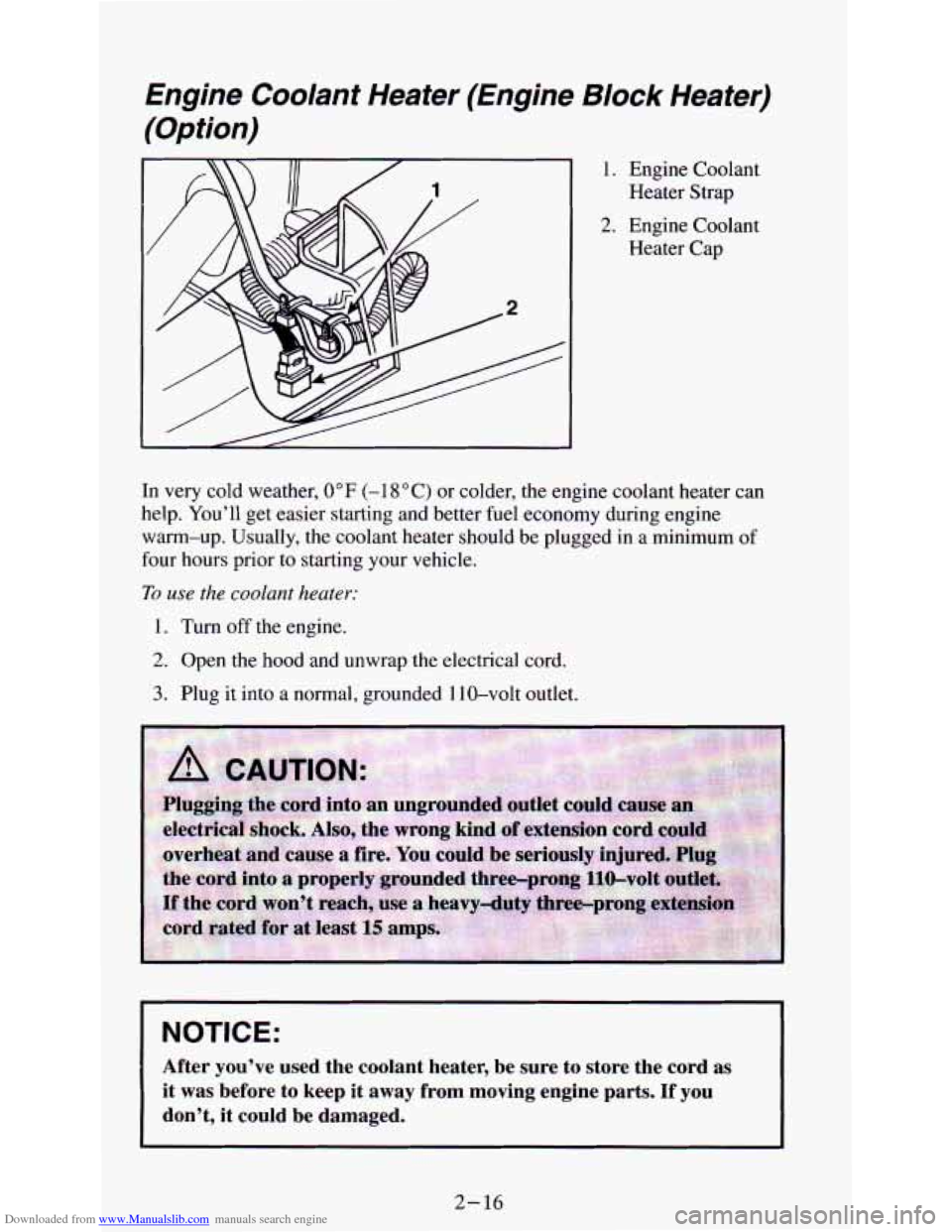
Downloaded from www.Manualslib.com manuals search engine Engine Coolant Heater (Engine Block Heater)
(Option) -
1. Engine Coolant Heater Strap
2. Engine Coolant
Heater Cap
In very cold weather,
0°F (-1 8 "C) or colder, the engine coolant heater can
help. You'll get easier starting and better fuel economy during engine
warm-up. Usually, the coolant heater should be plugged
in a minimum of
four hours prior to starting your vehicle.
To use the coolant heater:
1. Turn off the engine.
2. Open the hood and unwrap the electrical cord.
3. Plug it into a normal, grounded 1 10-volt outlet.
A CAUTION:
NOTICE:
After you've used the coolant heater, be sure to store the co\
rd as
it was before to keep it away from moving engine parts. If you
don't,
it could be damaged.
2- 16
Page 77 of 340
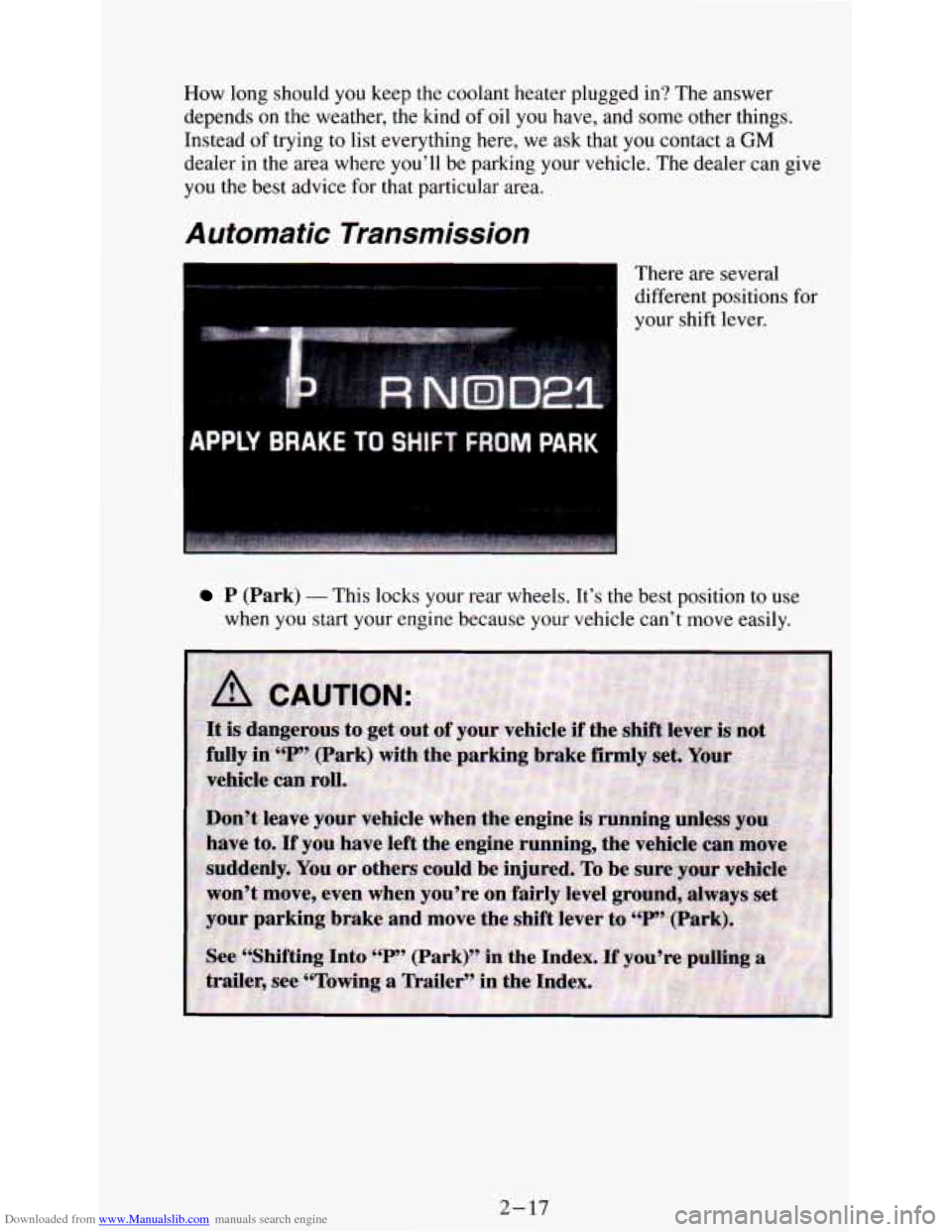
Downloaded from www.Manualslib.com manuals search engine How long should you keep the coolant heater plugged in? The answer
depends on the weather, the kind
of oil you have, and some other things.
Instead of trying to list everything here, we ask that you contact a
GM
dealer in the area where you’ll be parking your vehicle. The dealer can give
you the best advice for
that particular area.
Automatic Transmission
There are several
different positions for
your shift lever.
P (Park) - This locks your rear wheels. It’s the best position to use
when you start your engine because your vehicle can’t move easily.
2- 17
Page 78 of 340
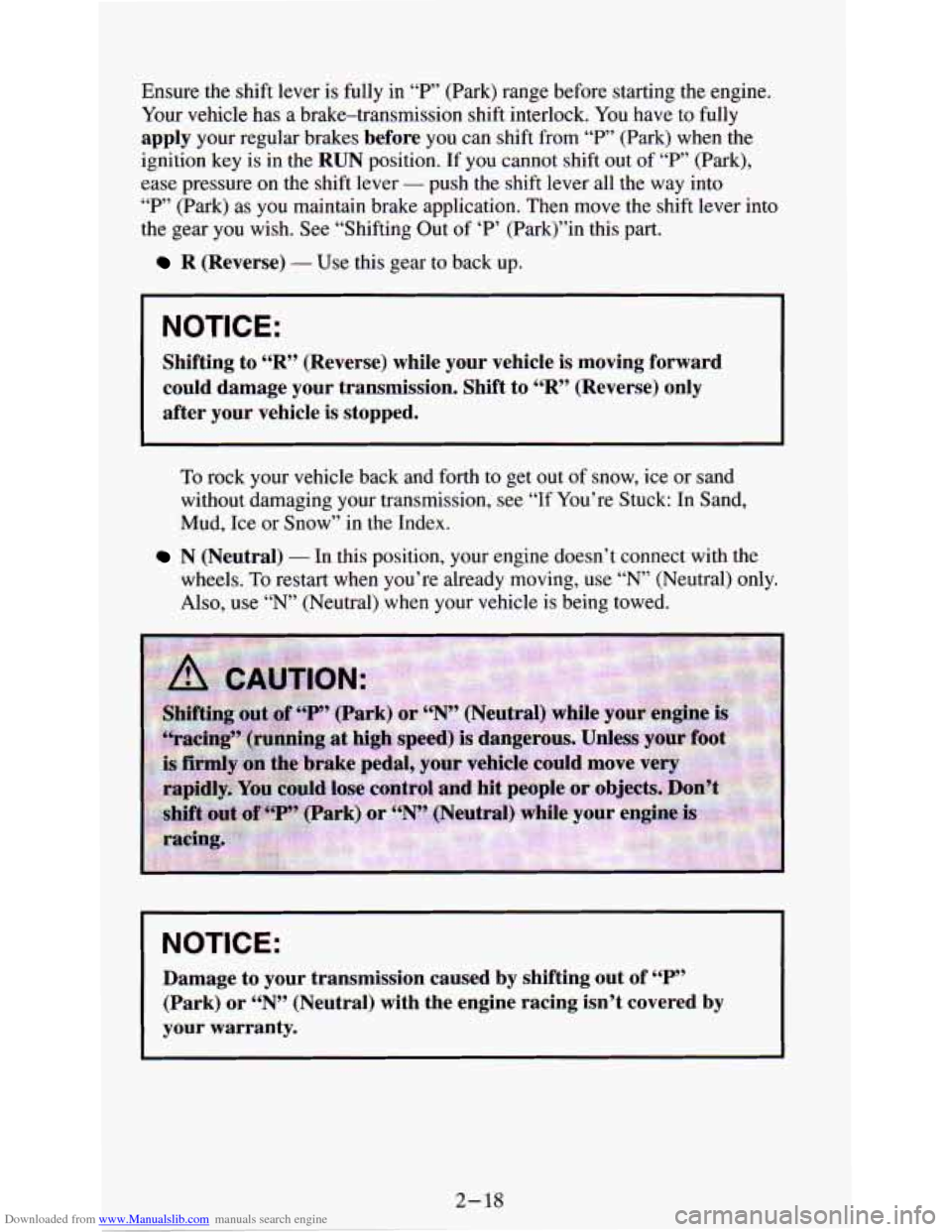
Downloaded from www.Manualslib.com manuals search engine Ensure the shift lever is fully in “P” (Park) range before starting the engine.
Your vehicle has
a brake-transmission shift interlock. You have to fully
apply your regular brakes before you can shift from “P” (Park) when the
ignition key is in the
RUN position. If you cannot shift out of “P’ (Park),
ease pressure on the shift lever
- push the shift lever all the way into
“P” (Park)
as you maintain brake application. Then move the shift lever into
the gear you wish. See “Shifting Out of ‘P’ (Park)”in this part.
R (Reverse) - Use this gear to back up.
NOTICE:
Shifting to “R” (Reverse) while your vehicle is moving forward
could damage your transmission. Shift to
“R” (Reverse) only
after your vehicle is stopped.
To rock your vehicle back and forth to get out of snow, ice or sand
without damaging your transmission, see
“If You’re Stuck: In Sand,
Mud, Ice
or Snow” in the Index.
N (Neutral) - In this position, your engine doesn’t connect with the
wheels. To restart when you’re already moving, use
“N’ (Neutral) only.
Also, use
“N” (Neutral) when your vehicle is being towed.
-
NOTICE:
Damage to your transmission caused by shifting out of “P”
(Park) or “N” (Neutral) with the engine racing isn’t covered by\
your warranty.
1
2- 18
Page 79 of 340
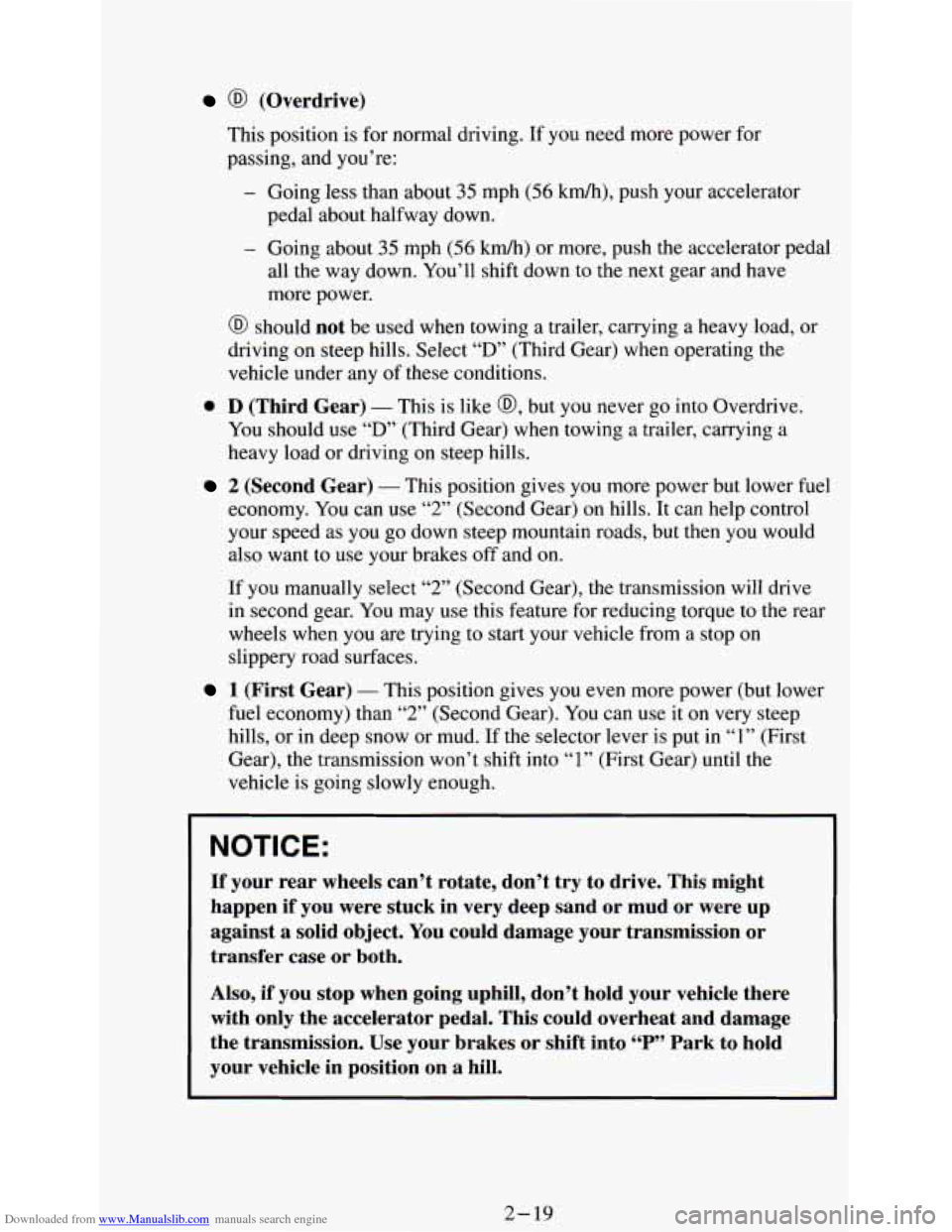
Downloaded from www.Manualslib.com manuals search engine @ (Overdrive)
This position is for normal driving. If you need more power for
passing, and you’re:
- Going less than about 35 mph (56 kdh), push your accelerator
- Going about 35 mph (56 kdh) or more, push the accelerator pedal
pedal
about halfway down.
all the way down. You’ll shift down to the
next gear and have
more power.
@ should not be used when towing a trailer, carrying a heavy load, or
driving on steep hills. Select
“D” (Third Gear) when operating the
vehicle under any of these conditions.
0 D (Third Gear) - This is like @, but you never go into Overdrive.
You should use
“D’ (Third Gear) when towing a trailer, carrying a
heavy load or driving on steep hills.
2 (Second Gear) - This position gives you more power but lower fuel
economy. You can use
“2” (Second Gear) on hills. It can help control
your speed as you go down steep mountain roads, but then you would
also want to use your brakes off and on.
If you manually select
“2” (Second Gear), the transmission will drive
in second gear. You may use this feature for reducing torque to the rear
wheels when you are trying to start your vehicle from a stop on
slippery road surfaces.
1 (First Gear) - This position gives you even more power (but lower
fuel economy) than
“2” (Second Gear). You can use it on very steep
hills, or in deep snow or mud. If the selector lever is put in
“1” (First
Gear), the transmission won’t shift into
“1” (First Gear) until the
vehicle is going slowly enough.
NOTICE:
If your rear wheels can’t rotate, don’t try to drive. This might
happen if you were stuck in very deep sand or mud or were up
against
a solid object. You could damage your transmission or
transfer case or both.
Also, if you stop when going uphill, don’t hold your vehicle there
with only the accelerator pedal. This could overheat and damage
the transmission. Use your brakes or shift into
“P” Park to hold
your vehicle in position on
a hill.
2-19
Page 80 of 340
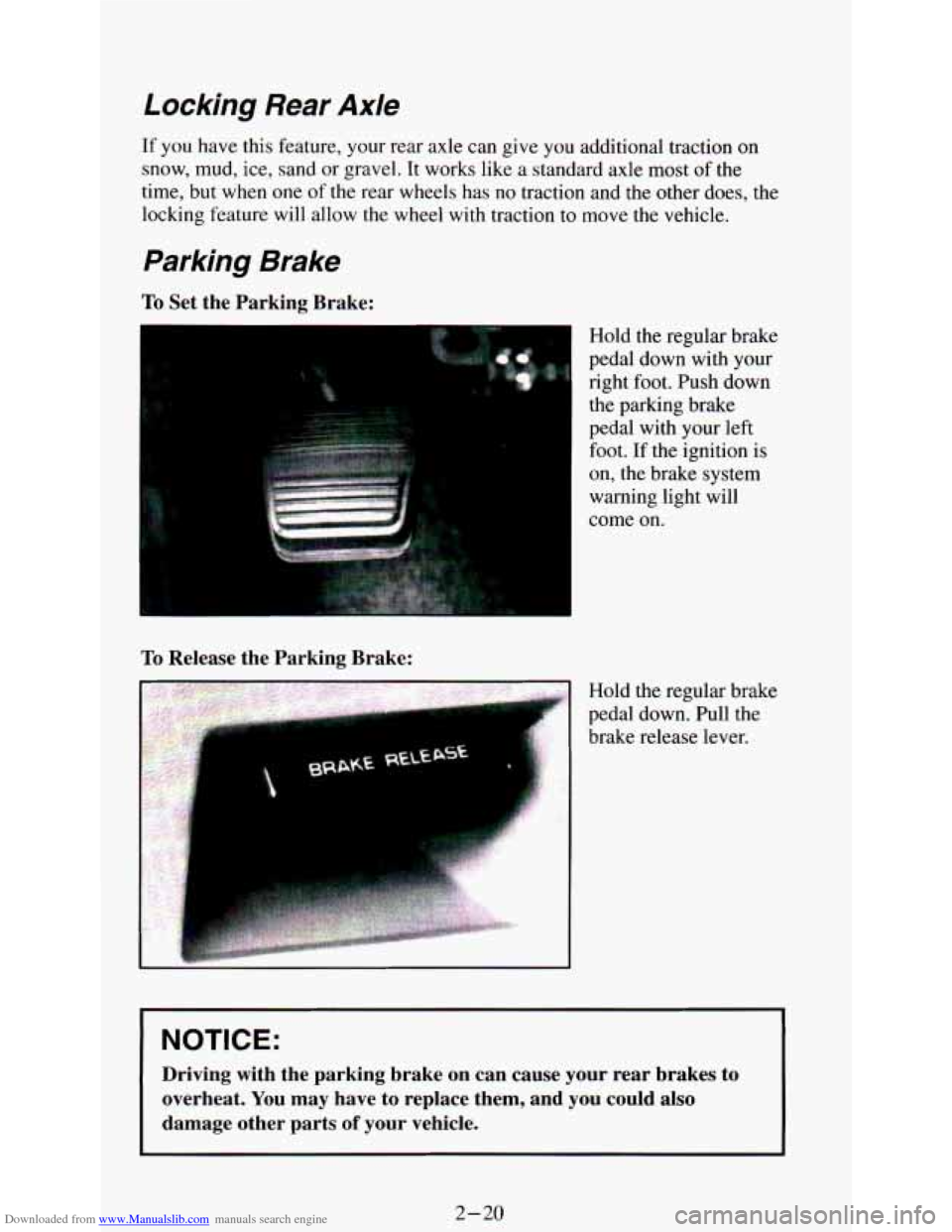
Downloaded from www.Manualslib.com manuals search engine Locking Rear Axle
If you have this feature, your rear axle can give you additional traction on
snow, mud, ice, sand or gravel. It works like a standard axle most of the
time, but when
one of the rear wheels has no traction and the other does, the
locking feature will allow the wheel with traction
to move the vehicle.
Parking Brake
To Set the Parking Brake:
I
I
Hold the regular brake
pedal down with your
right foot. Push down
the parking brake
pedal with your left
foot.
If the ignition is
on, the brake system
warning light will
come on.
To Release the Parking Brake:
Hold the regular brake
pedal down. Pull the
brake release lever.
NOTICE:
Driving with the parking brake on can cause your rear brakes \
to
overheat. You may have to replace them, and you could also
damage other parts
of your vehicle.
2-20